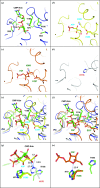Structural analysis of arabinose-5-phosphate isomerase from Bacteroides fragilis and functional implications
- PMID: 25286848
- PMCID: PMC4188006
- DOI: 10.1107/S1399004714017052
Structural analysis of arabinose-5-phosphate isomerase from Bacteroides fragilis and functional implications
Abstract
The crystal structure of arabinose-5-phosphate isomerase (API) from Bacteroides fragilis (bfAPI) was determined at 1.7 Å resolution and was found to be a tetramer of a single-domain sugar isomerase (SIS) with an endogenous ligand, CMP-Kdo (cytidine 5'-monophosphate-3-deoxy-D-manno-oct-2-ulosonate), bound at the active site. API catalyzes the reversible isomerization of D-ribulose 5-phosphate to D-arabinose 5-phosphate in the first step of the Kdo biosynthetic pathway. Interestingly, the bound CMP-Kdo is neither the substrate nor the product of the reaction catalyzed by API, but corresponds to the end product in the Kdo biosynthetic pathway and presumably acts as a feedback inhibitor for bfAPI. The active site of each monomer is located in a surface cleft at the tetramer interface between three monomers and consists of His79 and His186 from two different adjacent monomers and a Ser/Thr-rich region, all of which are highly conserved across APIs. Structure and sequence analyses indicate that His79 and His186 may play important catalytic roles in the isomerization reaction. CMP-Kdo mimetics could therefore serve as potent and specific inhibitors of API and provide broad protection against many different bacterial infections.
Keywords: Gram negative; Kdo (3-deoxy-d-manno-oct-2-ulosonate); arabinose 5-phosphate; lipopolysaccharide; structural genomics; sugar isomerase.
Figures






References
Publication types
MeSH terms
Substances
Associated data
- Actions
Grants and funding
LinkOut - more resources
Full Text Sources
Other Literature Sources
Molecular Biology Databases

